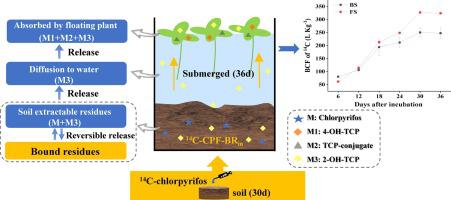Environment International ( IF 10.3 ) Pub Date : 2022-06-09 , DOI: 10.1016/j.envint.2022.107338 Jiayin Zhong 1 , Dahang Shen 1 , Hao Li 1 , Yan He 2 , Qian Bao 1 , Wei Wang 1 , Qingfu Ye 1 , Jay Gan 3

|
Chlorpyrifos (CPF) is a widely used organophosphorus insecticide that tends to form bound residues (BRs) in soils. However, the stability and biological activity of CPF-BRs remain to be explored. Facilitated by carbon-14 tracing, this study obtained CPF-BRs initially formed in two typical paddy soils (14C-CPF-BRin), and further investigated their release, transformation and phytoavailability using duckweed (Lemna minor) as a model aquatic organism. Most 14C-CPF-BRin in soils were composed of the parent CPF and its metabolite 3,5,6-trichloro-2-pyridinol (2-OH-TCP), which was mainly formed through reversible entrapment by soil fulvic acids and humin (>80%). At 36 d, 66.67–80.90% of the 14C-CPF-BRin was released, of which only 2-OH-TCP could be released into the water and absorbed by the duckweed, with bioconcentration factors ranging from 247.99 to 324.68 L kg−1. The subsequent metabolism of released 14C-CPF-BRin in duckweed included phase I metabolism from 2-OH-TCP to 4-OH-TCP and phase II metabolism of conjugation of TCP with plant endogenous amino acids. The study suggested that CPF bound residues have high bioavailability in paddy field environments. Given that many pesticides and non-pesticide chemicals share structures analogous to CPF, the findings have important implications for better understanding the environmental and human health risks of man-made chemicals.
中文翻译:

稻田土壤中毒死蜱结合残留物的归宿:释放、转化和植物有效性
毒死蜱 (CPF) 是一种广泛使用的有机磷杀虫剂,容易在土壤中形成结合残留物 (BR)。然而,CPF-BR 的稳定性和生物活性仍有待探索。在碳14示踪的帮助下,本研究获得了两种典型水稻土中最初形成的CPF-BR(14 C -CPF-BR ),并以浮萍( Lemnaminor)为模式水生生物进一步研究了它们的释放、转化和植物有效性。土壤中大多数14 C-CPF-BR由母体 CPF 及其代谢物 3,5,6-三氯-2-吡啶醇 (2-OH-TCP) 组成,主要是通过土壤黄腐酸和黄腐酸的可逆截留形成的。腐殖质(>80%)。36 d时, 14 C-CPF-BR的释放量为66.67%~80.90%, 其中只有2-OH-TCP能够释放到水中并被浮萍吸收, 生物富集因子范围为247.99~324.68 L·kg −1。浮萍中释放的14 C -CPF-BR的后续代谢包括从 2-OH-TCP 到 4-OH-TCP 的 I 相代谢以及 TCP 与植物内源氨基酸结合的 II 相代谢。研究表明,CPF 结合残留物在稻田环境中具有较高的生物利用度。鉴于许多农药和非农药化学品具有类似于 CPF 的结构,这些发现对于更好地了解人造化学品对环境和人类健康的风险具有重要意义。











































 京公网安备 11010802027423号
京公网安备 11010802027423号